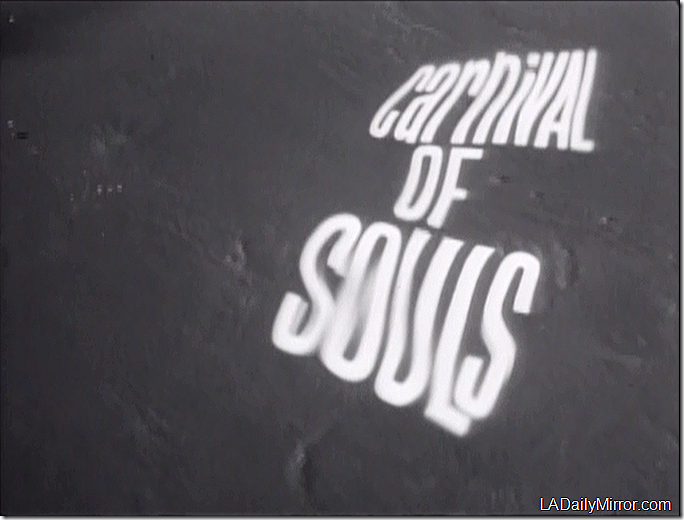
This week’s mystery movie has been the 1962 film “Carnival of Souls,” with Candace Hilligoss, Frances Feist, Sidney Berger, Art Ellison, Stan Levitt, Tom McGinnis, Forbes Caldwell, Dan Palmquist, Bill de Jarnette, Steve Boozer, Pamela Ballard, Larry Sneegas, Cari Conboy, Karen Pyles, T.C. Adams, Sharon Scoville, Mary Ann Harris, Peter Schnitzler, Bill Sollner. Photography was by Maurice Prather, screenplay by John Clifford, music by Gene Moore, produced and directed by Herk Harvey.
“Carnival of Souls” is available from Criterion on DVD ($23.96) and Blu-ray ($31.96).
Do make a point of reading E. Yarber’s comments on the film. Most rewarding and insightful!
Writing in the New York Times (July 19, 1989), Stephen Holden said:
What has earned ”Carnival of Souls” its reputation is the director’s knack for building a mood of fatalistic angst in the story of Mary Henry (Candace Hilligoss), a flinty, taciturn organist with Loretta Young cheekbones and a taste for macabre, expressionist keyboard music. After emerging miraculously unscathed from an auto accident that killed both her companions when their car plunged off a bridge, Mary decides to start life over in a new town, in a new job as a church organist. Her change of locale turns into a ”Twilight Zone”-like journey into another plane.
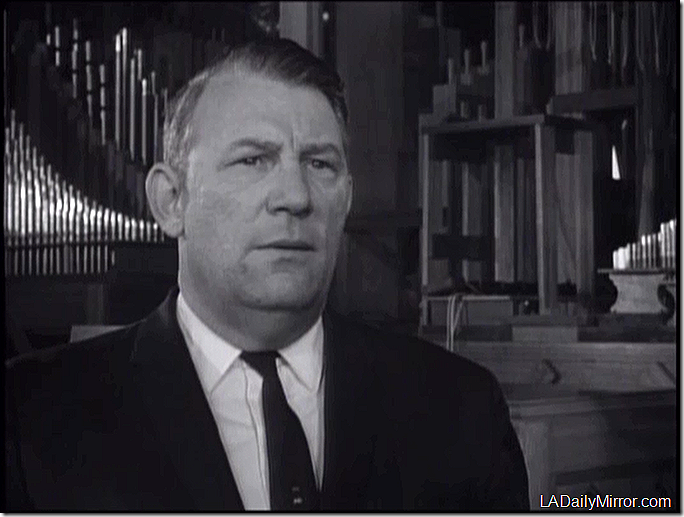
For Monday, we have a mystery gent.
Update: This is Tom McGinnis.
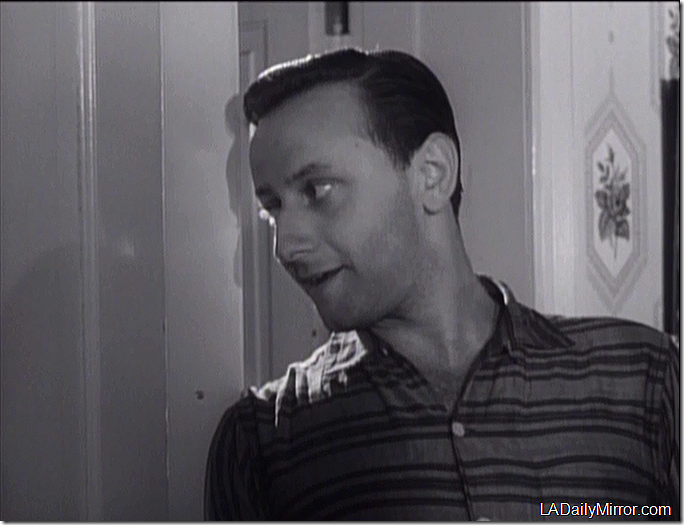
For Tuesday, we have a mystery gent.
Update: This is Sidney Berger.
Brain Trust roll call: Stacia (mystery movie and Monday’s mystery guest), Sheila (mystery movie) and E. Yarber (mystery movie and mystery guest — and as a bonus a little history of our mystery film!)
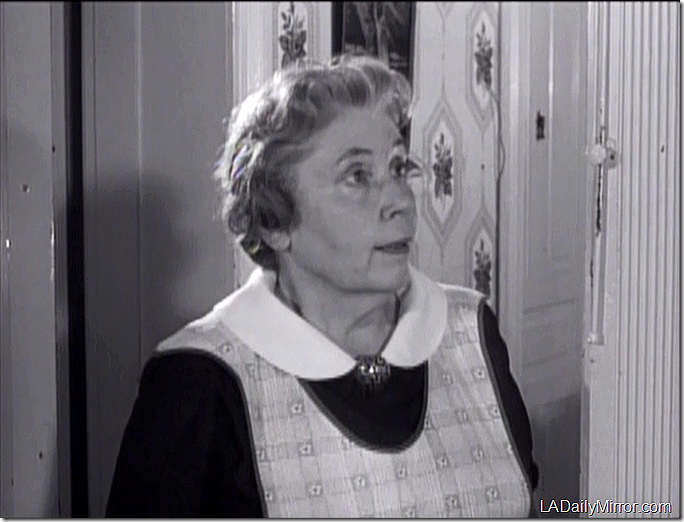
For Wednesday, we have a mystery woman.
Update: Update: This is Frances Feist.
Brain Trust roll call: Mary Mallory (mystery movie and Monday’s and Tuesday’s mystery guests), Mike Hawks (mystery movie), E. Yarber (Tuesday’s mystery guest and a nice essay on the film and Tuesday’s mystery guest).
Patrick: Yes, that was intentional. 🙂
And by all means check in when I post the comments to read what E. Yarber has to say about this mystery film. Also read his remarks on Orson Welles’ “Chimes at Midnight” and “A Bucket of Blood.”
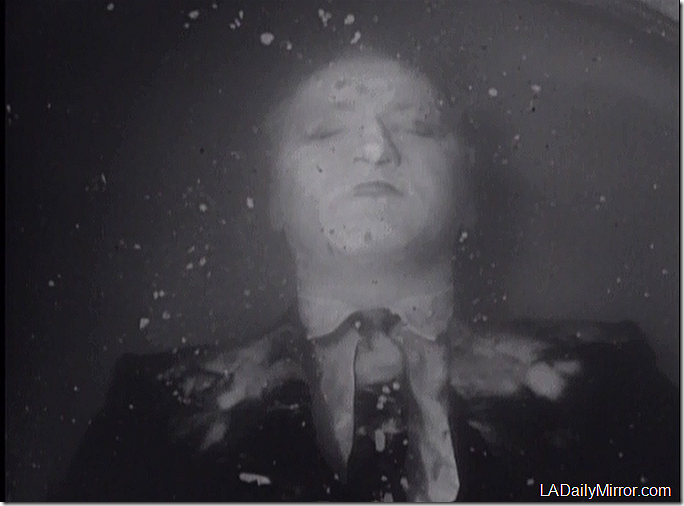
For Thursday, we have a mystery gent.
Update: This is Herk Harvey.
Brain Trust roll call: Mike Hawks (Wednesday’s mystery woman), Mary Mallory (Wednesday’s mystery woman), E. Yarber (Wednesday’s mystery woman — and yet another installment in an interesting essay on our mystery film), and Kathleen Geier (mystery movie — and yes, that was intentional).
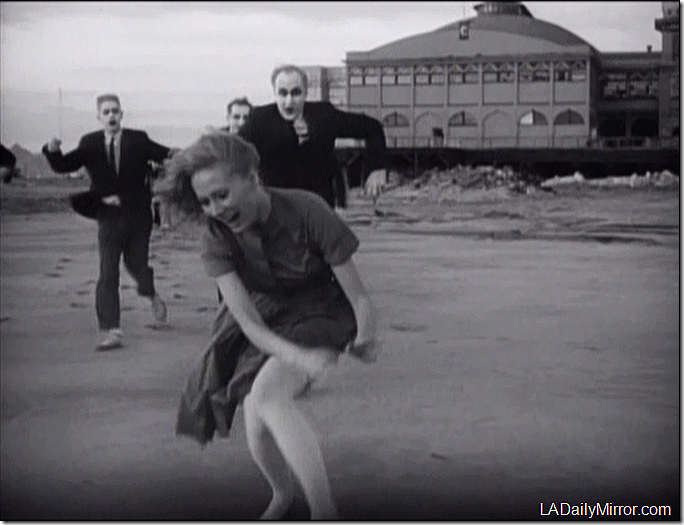
And for Friday, we have our mystery leading lady with some mystery zombies.
Update: This is Candace Hilligoss.
Brain Trust roll call: E. Yarber (Thursday’s mystery gent — plus the mystery gent’s bio), Mary Mallory (Thursday’s mystery gent) and Alan Warren (mystery movie).


That’s Tom McGinnis in Carnival of Souls
LikeLike
‘Carnival of Souls’?
LikeLike
Bronko Nagurski
LikeLike
You’re getting us ready for Halloween, I see. That’s Tom McGinnis in “Carnival of Souls.” It’s a fascinating little film, the only feature by Herk Harvey from the Centron Industrial Film company of Lawrence Kansas. Regional filmmaking at its best. While there are endless public domain copies floating about, I still prefer the deluxe Criterion package because sometimes an overlooked gem deserves full attention.
LikeLike
CARNIVAL OF SOULS and Tom McGinnis on Monday.
LikeLike
CARNIVAL OF SOULS.
LikeLike
Even considering that William Burroughs settled in Lawrence, Kansas in his final years, you’d tend to consider the place a haven for bland midwestern restraint. Yet in 1961 (one year before Carnival of Souls) Herk Harvey directed “Dance, Little Children,” a VD film aimed at high school students offering the clear message that people indeed have sex before marriage (even if the results are horror and disgrace).
Some of that same frankness comes through in Carnival’s character John Linden, played by Sidney Berger. Right from the start, he’s leering at Mary Henry and making no secret of his intentions toward her. It’s part of the perversity of the film that John winds up the most likable figure in it, always getting laughs from an audience. One reason is that he’s at least interested in pleasure, a life force in opposition to the death-drawn Mary. He’s also pretty harmless… if he had been presented as a good-looking boy-next-door type, a viewer might actually expect Mary to engage in a romance with him, but no one thinks for a moment that she’s going to give in to this smarmy twerp. His hopeless advances only accentuate Mary’s estrangement from any sort of human connection.
“Dance, Little Children” is on YouTube (dated 1965, but I use the year given in Ken Smith’s book Mental Hygiene – Classroom Films 1945-1970). Look it up if you’re curious to see the same sort of stilted acting and peculiar staging that made “Carnival” so unique a feature. Harvey and yesterday’s mystery man Tom McGinnis even appear in the short as concerned adults.
It’s interesting to note that George Romero’s “Night of the Living Dead,” inspired by “Carnival” in many ways, was also the work of a small midwestern production company that paid the bills by making industrial shorts. Both films have a matter-of-fact bare-bones approach that gives the horror a stark documentary look.
LikeLike
George C. Scott: The Early Years
LikeLike
Sidney Berger today.
LikeLike
I’m watching Carnival of Souls from 1962 on Turner right now so I’m not going to play.
LikeLike
Frances Feist.
LikeLike
Frances Feist today.
LikeLike
Wednesday’s figure is Frances Feist as landlady Mrs. Thomas. She’s another member of Harvey’s repertory players within the Centron educational films. In 1954’s “The Show-Off,” for example, she plays Mrs. Harvey, a parent disgruntled by the Eddie Haskell-like antics of an obnoxious student. (The Harvey family here was a sly way for the director to slip his own name into these anonymously-made shorts). The movie ends on an ambiguous note as the narrator asks the audience what they’d do about such a disruptive classmate, obviously a cue for the teacher to shut the projector off and lead a student discussion.
Many of Harvey’s films for Centron dealt with social issues that defied easy answers, yet another link to the alienated lead and uncertain atmosphere pervading “Carnival of Souls.” When taken out of context, these shorts have been regarded as campy misfires for decades now, but the makers themselves took them very seriously and had a good reputation within their field.
Centron was the brainchild of Russell Mosser and Arthur Wolf, who set up a rudimentary studio in an abandoned vaudeville theater behind the camera shop they ran. Despite these primitive conditions, they won a lucrative contract with a classroom distributor when a slick New York production company failed to deliver badly-needed product. With the University of Kansas only a couple blocks away, the company had access to an eager pool of talent, including theater arts major Harvey himself.
It’s worth noting that Centron actually produced an Oscar-nominated documentary in 1971 (not directed by Harvey, who’d left by then). “Leo Beuerman” is a character study of a well-known Lawrence personality, a watch repairman with a severely twisted body. The company was eventually absorbed into Gulf + Western, so it’s clear that no matter how their work may be remembered today, the little studio managed to impress the big money men.
LikeLike
This one is too easy for me because I just watched this film today. It’s Carnival of Souls.
LikeLike
One correction: though Harvey didn’t direct the Oscar-nominated documentary, he continued working at Centron until the mid-80s. I foolishly relied on an IMDb entry which omits his shorts after Carnival, and was corrected by a 1989 interview with Harvey on the Criterion set.
Too bad Centron isn’t around to do a cautionary film about a hapless adolescent who uses the internet as a substitute for direct source material!
LikeLike
Herk Harvey.
LikeLike
Carnival of Souls.
LikeLike
Turns out I should have waited a few hours to set the record straight on Herk Harvey, because Thursday brings us the man himself, as The Man in Carnival of Souls.
It’s an odd but effective portrayal. In a film full of conversations, The Man seems to have wandered into the picture straight out of a German expressionist feature of the 1920s, his silence allowing us to see him as alternately menacing and welcoming: the ambiguity of death itself. One of the great strengths of the film is that we can never get a handle on him, though he’s presented in a straightforward manner.
Harvey himself is easy to deal with. You can’t help but have a soft spot for a guy who spent fifty weeks a year churning out films-for-hire, then decided to spend his two-week vacation making a feature film for $20,000 dollars. Now that’s a guy who LOVES his job. Robert Altman also began his career by making industrial films in the midwest, but leapt at the chance to move to Hollywood for TV and movies. Herk stayed put in Lawrence for three-and-a-half decades. He felt uncomfortable with his leap to the big screen, not so much in making the film but having to deal with a shifty distributor who short-changed him.
Harvey seemed relieved when Carnival slipped entirely out of his hands. Like Night of the Living Dead, the distributor forgot to put a copyright notice on the title, sending it straight to public domain. As an orphan, it achieved cult status in the 60s chiefly by dint of being re-run constantly on late night television (the PD Little Shop of Horrors was another insomniac staple in those days). Ironically, Carnival was paired in drive-ins with “The Devil’s Messenger,” which WAS a TV show… three lashed-together episodes of a Swedish series featuring Lon Chaney Jr.
For Harvey and his screenwriter John Clifford, Carnival was an exercise in logistics. Herk had seen the abandoned Saltair resort in Utah and wanted to figure out a way to build a movie around it. That sort of backward thinking is the mark of a professional, someone who loves solving problems, which goes a long way toward explaining how he crafted such a compelling little gem in less time than it took Martin Scorsese to set up a shot. (The remark may seem like a cheap shot (ha!), but Scorsese was actually replaced by an industrial filmmaker on “The Honeymoon Killers” for exactly that reason).
After he retired, Harvey reclaimed his film. He restored some footage clipped from the original release and was delighted that it got an enthusiastic reception in art houses rather than the drive-in circuit. The times seemed to have caught up with it, or perhaps it was more accessible because its style had been imitated so often by then. Twenty-one years after his death, we’re still watching it.
LikeLike
Candace Hillgoss and Herk Harvey.
LikeLike
Candace Hilligoss in CARNIVAL OF SOULS.
LikeLike
Candice Hilligoss.
LikeLike
Like most of his Centron shorts, Harvey had to rely on drama students and local actors when casting Carnival of Souls. It’s fun to see a middle-aged Sidney Berger, by then the Chairman of the Drama Department at the University of Houston, looking back with amusement at his turn as John during the 1989 reunion of the participants.
But the role of Mary Henry had to carry the entire film, so Harvey went to New York and hired Candace Hilligoss, who’d studied under Lee Strasberg. She didn’t do much film work, appearing only in “The Curse of the Living Corpse” a couple of years later for Del Tenny, an unabashed exploitation filmmaker who used it as a co-feature for the surf-horror epic “The Terror of Party Beach. Roy Scheider also appeared in “Curse” and later wrote an amusing piece about his inept debut film.
Like nearly every stage actor in NYC, Hilligoss also turned up on an episode of the television series “Naked City,” in her case the season four opener “Hold for Gloria Christmas.” This episode has something of a cult reputation for a peculiar background detail. The opening sequence, filmed on a real street (as usual for the show), features Burgess Meredith going crazy around a newsstand prominently displaying both Amazing Fantasy #15 and Journey into Mystery #83. For non-comic-book fans, these are the issues that respectively introduced Spider-Man and the Mighty Thor. A mint edition of any single copy of those comics would go for close to a million dollars on the collector’s market today, and there you can see dozens lined up for twelve cents a throw.
When we observe her once-in-a-lifetime job in Carnival of Souls, however, you can really see what an inspired touch Harvey made in bringing a Method-trained actor into his picture as the lead. While most of the performers are basically hitting their lines, Hilligoss is emoting, reacting, FEELING. The difference in acting styles leaves the lead seeming out-of-synch with those around her, just as The Man appears to have wandered in from a silent horror picture. It creates a sense of alienation for Mary perfectly in keeping with her character, yet completely authentic. You see her as a tortured soul surrounded by well-meaning but imperceptive strangers. Only The Man and his minions seem to truly understand her condition, a truth she doesn’t want to face. Such casting is a perfect case of making your limitations work for you.
Mary is often compared to Judith O’Dea’s Barbara in Night of the Living Dead, but the characters are different extremes. Barbara goes insane early in NOTLD and is regarded as inconvenient baggage by her fellow survivors. Mary is the center of her story, every character drawn to her and seen solely in relation to her. It’s her will power alone that keeps her going even as she’s being inexorably drawn into the darkness and that tension sustains our interest throughout a plot that is not intended to make complete sense until the final moments of the film.
I’ve seen a lot of people try and fail to pull off trick endings. Most of the time it’s because they don’t understand that an audience is not going to sit still for a writer trying to justify eighty minutes of pointless activity by loudly dropping a tray of plates at the end. That’s putting all your eggs in one basket. Generally, you have to rely on misdirection, creating a story that works on two different levels. The audience thinks they’re watching Plot A, but at the crucial moment you reveal that they’ve been watching Plot B all along. With luck you’ll get your audience to buy a second ticket so they can observe how neatly every step of the story operates on Plot B once you’re in on the joke.
What’s fascinating about Carnival of Souls is that it works even though Harvey and Clifford don’t give us a Plot A to keep everything in a sort of context until the revelation. We’re as puzzled as Mary, and Mary is subconsciously extending that disorientation as long as possible because the answer is fatal for her. Night of the Living Dead establishes a firm premise in the first few minutes and proceeds to work through the escalation of that SITUATION. Carnival of Souls, by contrast, begins with a puzzle and proceeds to work though the escalation of MOOD alone. This is very difficult storytelling, and it takes a shrewd understanding of both character psychology and audience psychology to make it work.
I first saw this film in its restored version with an appreciative audience. Everyone had a lot of fun watching it. But just as Joyce and Faulkner and Beckett are often considered “writers’ writers” because it takes a certain level of technical understanding to fully appreciate their achievements, this one-off feature is a lot more sophisticated than its low-budget trappings might indicate. Harvey was right to feel it belonged in art houses, and I think it fully deserves the box set the Criterion people gave it. Even in the cheapest public domain packaging or streaming online link, however, it remains entertaining even after multiple viewings, and that’s what really counts.
LikeLike